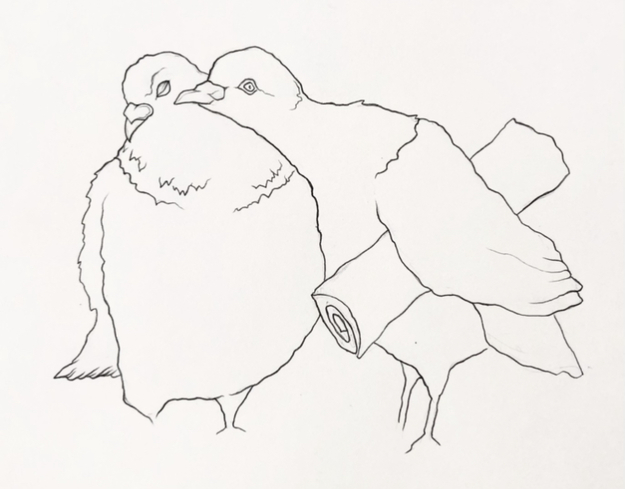Stories can take up a myriad of forms. They can start as accurate recounts of reality but when they circulate, they are simplified, stretched out, distorted, dismissed, and often made humorous. Like a widespread game of telephone with cultural diffusion, information reaches us through filters. We tend to construct our assumptions about people through the gossip we hear from our friends, we go to places because they have been recommended to us and we place importance on things because someone or something convinced us they are important. Donna Haraway, in her book “Staying With The Trouble, Making Kin in the Chthulucene” explores these dynamics of storytelling and compares them to string figure games. She stresses the intricacy and riskiness concerned with storytelling and its importance in the creation of our worldview. Changing a few words in a story can alter its meaning and emphasis and can have detrimental effects on how the recipient subsequently perceives reality.
The pigeon, for example, has been a central topic in many tales and has been highly contested throughout history. Stories have traveled simultaneously depicting it as a hero, an agent with profound importance as well as being portrayed as a menace, “a rat with wings”. Pigeons have been spies, racers, messengers, urban neighbors, subjects for scientific research, search and rescue workers at sea, companions, carriers of disease, targets of extermination…
But who recounted these stories? Who said pigeons are any of these things? Donna Haraway emphasizes the importance of looking at who is speaking. Who are the agents that are sharing these stories, in what context are they doing so, and with what authority? She writes
“It matters what matters we use to think other matters with; it matters what stories we tell other stories with; it matters what knots knot knots; what thoughts think thoughts, what descriptions describe descriptions; what ties tie ties. It matters what stories make worlds, what worlds make stories”
To rid ourselves of prejudices and biases about pigeons, we must understand them. We have to reshape the stories and gossip and re-form the relationship between ourselves and them so that we can ultimately live in cooperation and both flourish.
The inhuman carnival is our attempt to do so. We will transform ourselves into them, move like them, eat like them, and try to become them. We will dance as pigeons, adorn ourselves with their feathers, mirror their colors, and adjust to their eyesight. By focusing on the pigeon, we are celebrating them as well as trying to comprehend how they relate to us. Pigeons are a companion species, we live together and share the same space. This proximity allows for a reciprocal relationship between us and them, one which can provide much insight and comfort. Our lives intertwine like a web of strings. We share similar ways of orienting ourselves through chaotic spaces and we gather together on the surfaces of crooked benches in the town’s square. Every day we pass by each other, share glances, form opinions and then proceed to our next destination.
How can we better our relationship so that we can live harmoniously together?
